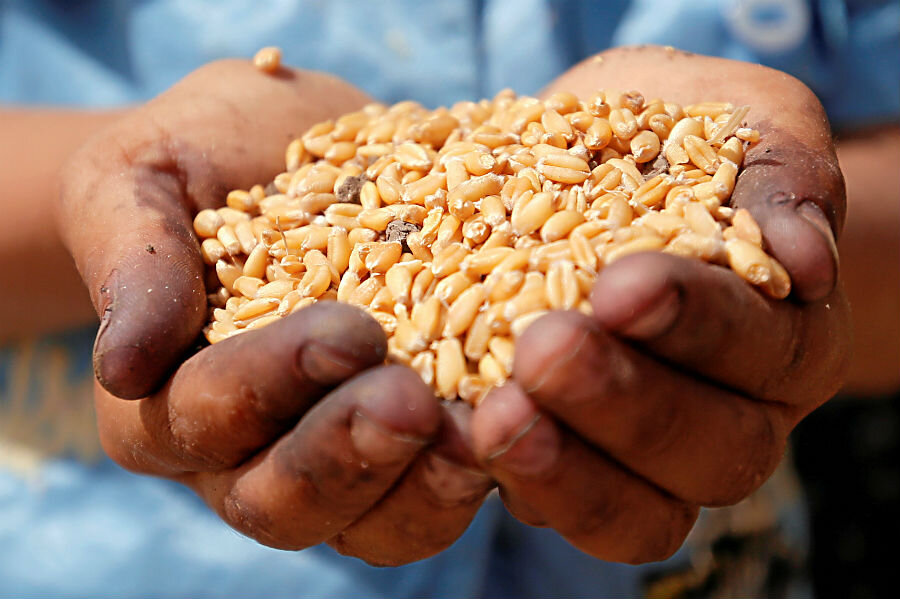Could ancient wheat species play a big role in the future of food?
Loading...
Einkorn, emmer, and spelt are ancient species of wheat that were integral to the diets of our ancestors, but have largely faded into memory, replaced by a select number of crops that dominate fields the world over.
In fact, of the 30,000 edible plant species known to science, a mere 30 represent the crops that feed the world. Of those, five cereals (rice, wheat, maize, millet and sorghum) provide 60 percent of mankind’s energy intake.
Yet a bewildering array of those outmoded varieties remain accessible, many lying frozen in gene banks. A new research paper, published Monday in Trends in Plant Science, advocates their resurrection, suggesting that the reintroduction of more diversity could bring many benefits.
“Extreme focus on few species and accessions has led to a large loss of biodiversity,” write the authors, “with negative consequences such as the extinction of species, vulnerability of ecosystems, and difficulties to meet future agricultural demands, because genetic variability to provide climatic and pest adaptation is lost.”
Moreover, the researchers suggest that the time is ripe for such a reintroduction, considering the burgeoning demand for high-quality, healthy food.
"People are interested in diversity, in getting something with more taste, with healthier ingredients, and ancient grains deliver interesting things," said co-author Friedrich Longin in a press release.
Many people’s attitudes today, particularly in the United States and Europe, give primary consideration to characteristics other than cost, making such proposals realistic in a way that they may not have been in decades past. Niche markets for small farmers, bakers and millers have become feasible again.
Already, multi-grain products such as breads and baked goods are popular, containing ingredients such as oats, millet, and barley, but the wheat flour employed is almost exclusively from bread wheat, just one of three species, 20 subspecies and thousands of varieties of wheat that have been cultivated and consumed over the millenniums.
Globalization and the explosion of industrial agriculture in the 20th century narrowed the range of crops being grown, ever seeking those that provided the highest yields, the shortest stalks – to prevent collapsing – and the best resistance to pests. Any varieties that failed to meet these criteria fell from favor.
In determining which plants make suitable candidates for reintroduction, these qualities would still be important, but a more holistic approach would be required, say the authors, incorporating other factors such as taste and nutrition. Their own research has demonstrated the importance of considering the whole range of variables.
"When you look at einkorn, it is really fantastic looking in the field,” said Dr. Longin, “but when you get the agronomic performance, it is low yielding and it falls down in the rain. But then we found there were so many healthy ingredients, and you taste and even see it in the end product."
Spelt serves as an illustration of how such reintroduction can breed success. In southern Germany, Austria, and Switzerland, it was the dominant cereal crop until the early 20th century, when it all but disappeared. Its rediscovery in the 1970s met with a slow beginning, as all but a handful of millers and bakers were still familiar with traditional spelt recipes.
Spelt had originally fallen out of fashion in no small part due to agronomic problems centered round its long stem, resulting in "lodging" – the collapse of the stem when it can no longer support its own weight – which in turn had a negative impact on the harvest. A breeding program beginning in the late 20th century sought to address this, and by 2000, spelt was producing 20 percent higher yields than original varieties. Marketing and research then contributed to boosting spelt's appeal, highlighting "an enormous richness of the spelt breads in texture and flavor," as the authors describe it, emphasizing the diversity it could contribute to our diet.
Today, the crop blankets more than 100,000 hectares of land in and around Germany, provides an annual turnover of €1 billion ($1.1 billion) and an annual growth rate of five percent.
But if other varieties are to meet with similar success, say the researchers, there will need to be an interdisciplinary approach, with cooperation all along the supply chain, from plant breeders and nutritionists, to marketing and vendors.
"It would be worthwhile to look a bit more in the gene banks at what diversity is sleeping there that has been forgotten by the industry," said Longin.






